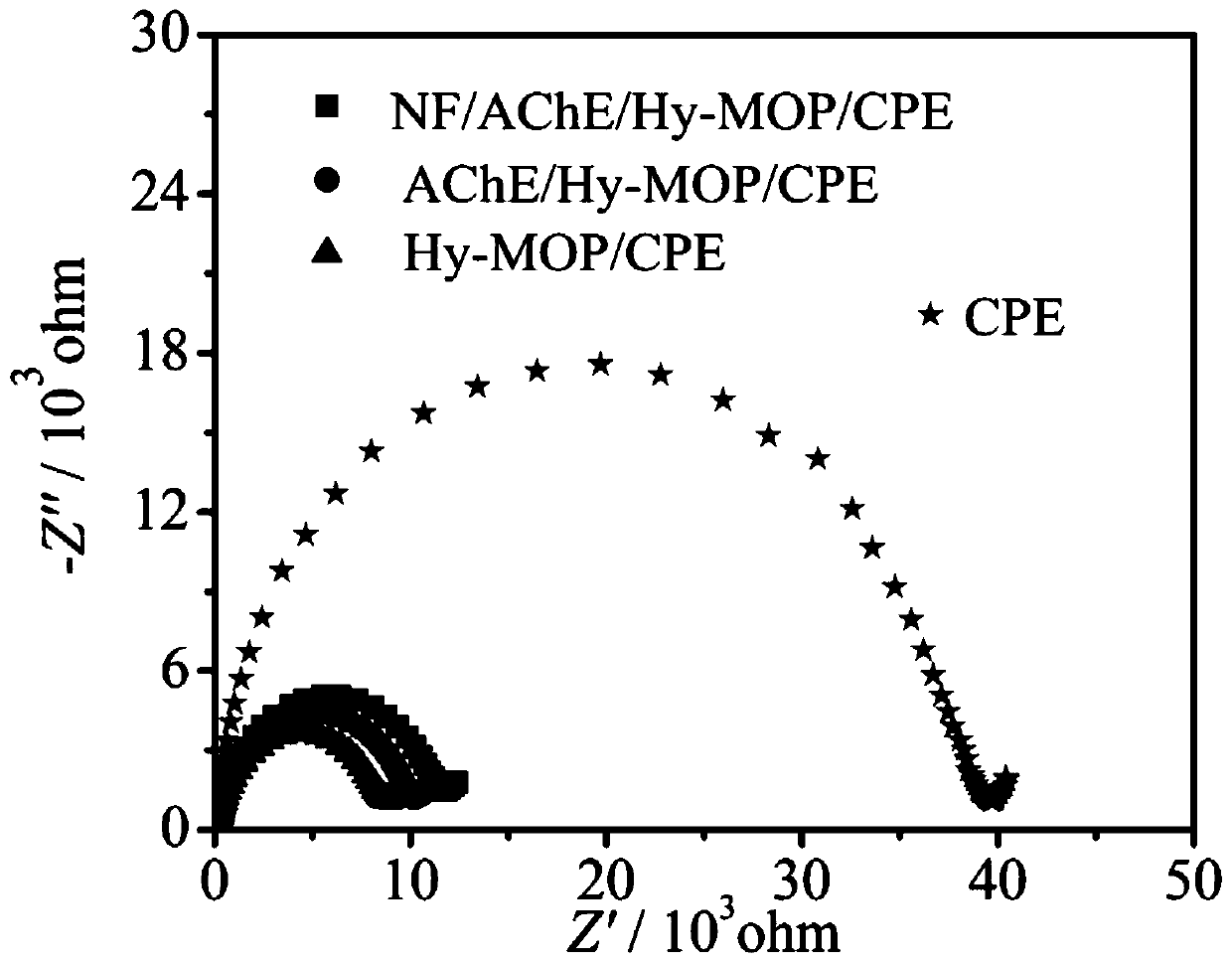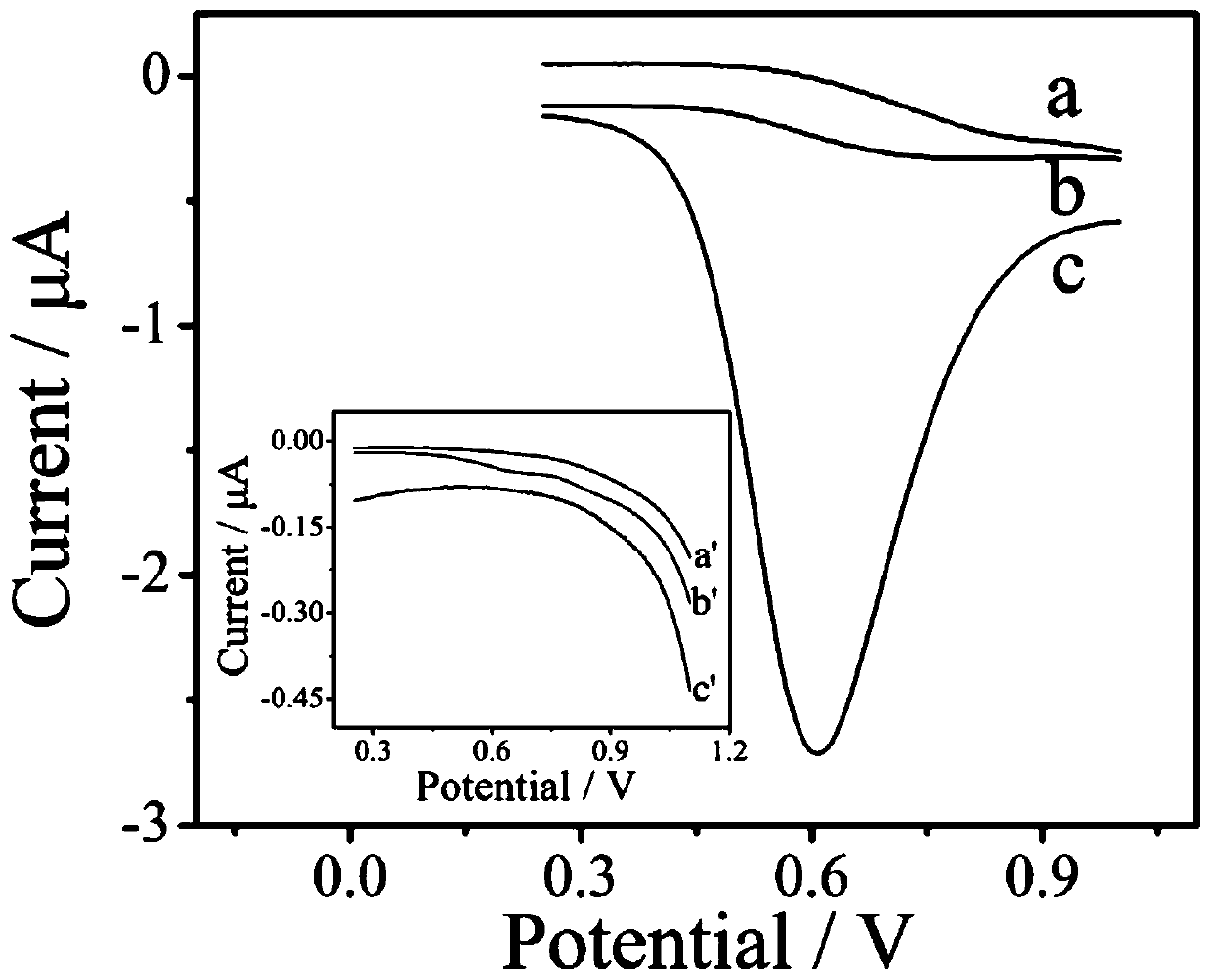Hydroxyl-containing microporous organic polymer organophosphorus pesticide biosensor and preparation method
An organophosphorus pesticide and biosensor technology, applied in instruments, scientific instruments, measuring devices, etc., can solve the problems of on-line and rapid analysis and monitoring of environmental and food pollution, complex sample pretreatment, and expensive instruments. Sensitivity and stability, short preparation time, low cost effect
- Summary
- Abstract
- Description
- Claims
- Application Information
AI Technical Summary
Problems solved by technology
Method used
Image
Examples
Embodiment 1
[0057] This embodiment provides a kind of preparation of Hy-MOP, and this method comprises the following steps:
[0058] Step 1. Dissolve phloroglucinol and terephthalaldehyde in 1,4-dioxane respectively, then add hydrochloric acid, react in microwave for 2 hours at 250W, and naturally cool the obtained brown product to room temperature;
[0059] Step 2, placing the brown product obtained in step 1 in tetrahydrofuran, stirring, suction filtering after the stirring, and washing the filter cake to obtain a brown solid;
[0060] In step 3, the brown solid obtained in step 2 is dried to obtain the Hy-MOP product.
[0061] As a specific example of this embodiment, the preparation of the Hy-MOP includes the following steps:
[0062] In step 1, 1.0 g of phloroglucinol and 0.8 g of terephthalaldehyde were dissolved in 10 mL of 1,4-dioxane, respectively, and put into a 25 mL three-necked flask. Subsequently, 2 mL of hydrochloric acid (mass concentration: 37%) was added, and microwave...
Embodiment 2
[0066] This embodiment provides a hydroxyl group-containing microporous organic polymer organophosphorus pesticide biosensor, including a carbon paste electrode, an acetylcholinesterase layer, and a Nafion layer. The modified layers on the surface of the carbon paste electrode are Hy - MOP layer, acetylcholinesterase layer and Nafion layer.
[0067] Wherein, Hy-MOP adopts the Hy-MOP prepared by the preparation method of Example 1.
[0068] The preparation method of the hydroxyl group-containing microporous organic polymer organophosphorus pesticide biosensor of this embodiment, such as figure 1 As shown, the method includes the following steps:
[0069] Step 1, ultrasonically dispersing Hy-MOP powder in a solvent to form a Hy-MOP suspension; the concentration of the Hy-MOP suspension is 10 mg / mL;
[0070] In step 2, pipette 6 μL of the Hy-MOP suspension prepared in step 1 and drop-coat the surface of the carbon paste electrode, and place it at room temperature to dry to obta...
Embodiment 3
[0087] The electrochemical impedance of different modified electrodes in embodiment 2: figure 2 It is the EIS diagram of different modified electrodes. It can be seen from the figure that the arc radius corresponding to the high-frequency region in the impedance diagram of CPE is the largest, indicating that its electrons are difficult to transfer on the surface of the CPE; the impedance diagram of the Hy-MOP / CPE modified electrode is high The radius of the arc in the high-frequency region is greatly reduced, indicating that the Hy-MOP material has good electron conductivity; when the insulator AChE is further modified on the surface of the Hy-MOP / CPE electrode, it is found that the corresponding impedance arc radius has increased. Large, indicating that AChE was successfully immobilized on the surface of the Hy-MOP / CPE electrode.
PUM
| Property | Measurement | Unit |
|---|---|---|
| Concentration | aaaaa | aaaaa |
| Linear correlation coefficient | aaaaa | aaaaa |
Abstract
Description
Claims
Application Information
 Login to View More
Login to View More - R&D
- Intellectual Property
- Life Sciences
- Materials
- Tech Scout
- Unparalleled Data Quality
- Higher Quality Content
- 60% Fewer Hallucinations
Browse by: Latest US Patents, China's latest patents, Technical Efficacy Thesaurus, Application Domain, Technology Topic, Popular Technical Reports.
© 2025 PatSnap. All rights reserved.Legal|Privacy policy|Modern Slavery Act Transparency Statement|Sitemap|About US| Contact US: help@patsnap.com



